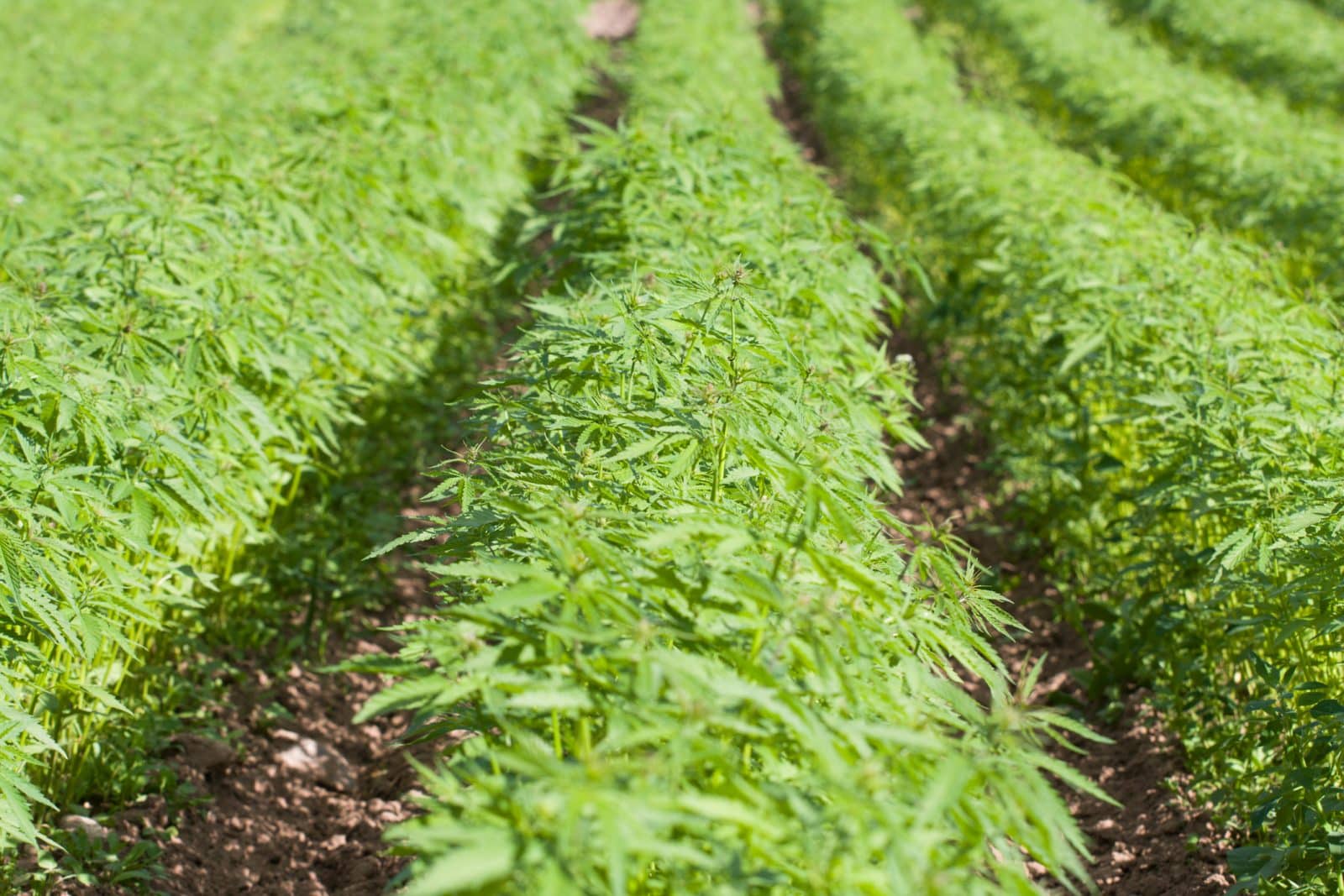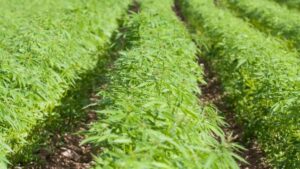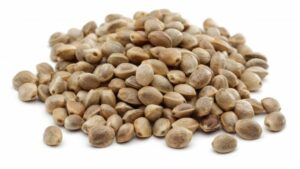While the golden child CBD pulled hemp into popularity, fiber and grain prove to be more lucrative markets for the future.
After a 67-year hiatus, industrial hemp has found its acreage again in the U.S. The U.S. “hemp rush” started in 2018 — similarly to the Gold Rush, farmers across the country raced to get acres planted dedicated to hemp fields. But, like the Gold Rush, all good things must come to an end. And while hemp acreage hasn’t halted completely, it certainly has dropped significantly since that first year.
According to the U.S. Department of Agriculture Economic Research Service (USDA ERS), by mid-2019, 47 states had passed legislation to allow some form of hemp production, and acreage increased from zero in 2013 to over 90,000 in 2018. In 2020, the acreage dropped significantly as pricing fell from July 2019 to December 2020, from almost $5.00 per CBD percentage to less than $1.00 per CBD percentage. The ERS notes that hemp competes for acreage against crops with established markets and decades of agronomic research and industry experience, making it difficult to establish.
“The hemp industry is going through a lot of growing pains,” says Tyler Mark, associate professor of production economics in the Department of Agricultural Economics at the University of Kentucky.
That only begs the question: is industrial hemp a lucrative market in 2021-2022 in the U.S., or has the cash cow dried up?
A CBD Gold Mine or Bad Harvest?
When it comes to CBD, Mark says that it’s almost like Willy Wonka and the golden ticket — there’s opportunity, but right now, it’s more of a rare, lucky break than the standard.
“A lot of acres capped out in the 2019 year, when we had hit prices or biomass prices in that $4.50 to $5.00 a point per CBD percentage point range,” he says. “But, there was a lot of excitement in that space when CBD came onto the front. Unfortunately, prices peaked out in July 2019, and then have kind of been on a downward slide ever since.”
So, not only has CBD prices fallen at the wholesale level, but because of it, at the farm level as well.
One negative aspect that looms over the CBD space is the Food and Drug Administration (FDA).
“We’re still trying to clear up the regulations and other regulatory framework for CBD,” says Mark. “That means, a lot of companies are still sitting on the sidelines until they know what the regulatory space is really going to look like.”
However, in terms of CBD, Mark says the industry won’t see any real regulatory clarity until human trials are completed.
Mark notes, though, that various extraction methods — the techniques used to extract CBD from the floral material — are branching out into more spaces. CBD, other cannabinoids, terpenes and delta-8 are all opportunities opening.
Delta-8 THC is a psychoactive substance found in hemp plants, and while it is one of over 100 cannabinoids produced naturally by the plant, it’s not found in significant amounts.
“Delta-8 is pretty controversial,” Mark says. “It does naturally occur in the hemp plant, but it doesn’t occur in any type of economically viable component until it’s converted from the CBD isolate.”
In addition, delta-8 has not been FDA approved. According to the FDA, has had an uptick in adverse event reports to the FDA and the nation’s poison control centers.
While CBD was the thought to be the cash cow of the industrial hemp market, other markets might prove more viable.
The Grain and Fiber Market Potential
Though CBD was the first market to really take the spotlight, two other hemp markets loomed in the shadows: grain and fiber.
“The grain and fiber side of things have really struggled, sitting second fiddle to the CBD industry,” Mark says. “But that’s really where I think a lot of individuals thought the hemp industry was going to go to initially. CBD came onto the scene and took the spotlight away, but we’re seeing more spotlight put back on the grain and fiber sectors.”
One company that is excited about this new spotlight is New West Genetics, located in Fort Collins, Colo.
“We’ve seen a decrease in CBD acreage in 2019 and in 2020 as well, but we’re seeing a pickup again in 2021 acreage on the grain and fiber side,” says Wendy Mosher, CEO of New West Genetics. “Though, I’m glad we saw that CBD decrease. Everyone was so excited about CBD, no one did the math on how many acres you actually need to serve that market.”
Realistically, there’s been quite the disconnect between how many acres of hemp you need to produce to meet the demand of CBD. Mosher says a recent report published by Pan Exchange, estimated that only about 10,000 acres was needed to fill current demand for CBD.
However, as both Mosher and Mark mentioned, that disconnect led to a bigger spotlight on other CBD markets.
Mosher, in particular, is keen on the grain market.
“Now, you think after the roller coaster in the world of CBD, there would be a more even approach to focus on all parts of the hemp plant,” she says. “However, what we’ve seen is a flocking to fiber and still very little focus on grain.”
While New West Genetics is completely in favor of the fiber market and the potential applications, Mosher says the markets, products, as well as processing techniques are still being figured out.

“I’m starting to see it pick up, and I have a lot of hope,” she says. “But, the grain market is happening now, let’s focus there.”
According to Mark, Canada would be the U.S.’s biggest
competitor on the grain side of things, while Europe and China are big competitors on the fiber side.
“We’re behind on those two components, behind in terms of research,” Mark says. “We’re trying to play catch up on that, but there’s a lot of excitement on the grain and fiber space.”
When it comes down to it, though, Mosher says there’s still a lot to learn about both industries — especially on the grain side.
“Grain is the big opportunity, and the industry is still missing it,” Mosher says.
“When I speak to fiber producers and CBD producers, many times they aren’t aware of the excellent nutrition qualities of the grain,” she says. “How can we expect ingredient and CPG companies to know if we, as an industry, don’t know ourselves? Hemp grain addresses both the protein and the omega-3
markets, a large addressable market — the fiber market is a good-sized market for sure but is about half the size of those two addressable grain market segments.”
To put it in perspective, Mosher mentions than every year on average, the U.S. grows 80 million acres of soy. The protein plus the omega-3 markets worldwide are around $90 billion
combined, whereas in comparison, the fiber market is around $58 billion.
Why shouldn’t hemp grain be used in addition or as a rotation with soy to serve that protein market, and in addition or as a rotation with canola for those healthy fatty acids? According to Mosher, they provide an equal if not superior option for grain applications.
That, she says, is the large acre opportunity.
“Again, we love and are excited about the fiber market, but it’s still in its infancy in the U.S.,” she says. “They’re making awesome, exciting products, especially in the building materials space, but those products still have some perfecting to do before they can compete in the market.”
Seed Genetics Play into Markets
While these markets are all in their infancy and still working on creating new products and new opportunities, it’s important to remember how seed genetics come into play for these markets.
Mark notes that one difference between the U.S. markets and other markets is seed genetics.
“Right now, we’re bringing in a lot of genetics from other countries and we’re trying to adapt them into the latitudes and production practices we have here in the U.S.,” Mark says. “When you look at a lot of the Canadian varieties that are grown, they have 30+ years on us.”
What does it mean to have 30+ years of research and fine-tuning in the hemp seed industry?
“Those varieties produce THC that consistently stay below the THC threshold, they don’t have plants going hot, because they’ve got years of breeding for their conditions,” he says. “We’re trying to bring them down and put them in a different latitude, and that’s been a struggle.”
However, even though hemp hasn’t been in production since the 1950s, Mark says there’s still plenty of time for the U.S. to catch up — but it’ll take some time.
In terms of genetics within the U.S., Mosher says quality is certainly improving.
“We’ve been established since 2014 — if you think it’s the wild west now, you should have seen it then,” she says. “The hemp industry is really gaining knowledge on the certified seed side; we’ve come a long way.”
Mosher says it’s imperative to understand the importance of certified seed and understanding specs within the seed.
“In a typical crop, you’d say success is based on 50% genetics, 50% agronomy,” she says. “In this industry, because the genetics were not stable and ill-bred for adaptation to regions, flowering time, etc., I’d say the genetics were even more important.”
Having genetics that are bred as close to your region as
possible is key.
“Using imported seed from Canada or Europe will have a yield impact — it will not yield the same as it does in the region it was bred,” Mosher says.
Finally, ensuring THC compliance is key to look for in seed genetics.
“The Cornell and CSU studies showed that cannabinoid control is due to genetics, not environment. Varieties must be bred generation after generation, with high selection pressure to ensure that cannabinoid stability. The good news is once you’ve gotten there, it stays there because it is under genetic control,” Mosher says.
As for her advice? Do your research on genetics.
“Hemp is a risky crop already,” Mosher says. “When you don’t do your research on the genetics side, it’s a recipe for failure.”













